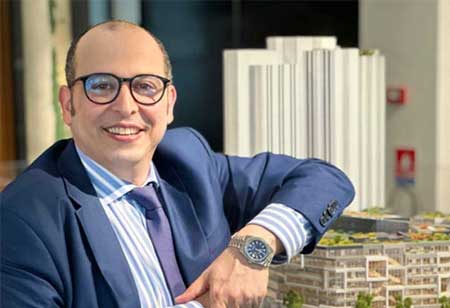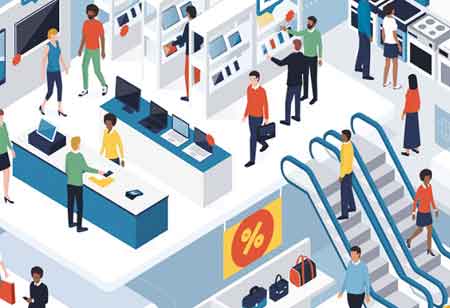Thank you for Subscribing to Construction Business Review Weekly Brief

Temporary Construction: The Future of Sustainable Real Estate Investment
Moad Ziadi is currently Project Management Director Europe of Unibail-Rodamco-Westfield the world's largest commercial real estate company acting in Europe and the US. His more than 25 years career has given him the opportunity to carry out activities in the field of development and construction within an international context particularly in Caribbean Sea, Russia, Singapore, the Middle East and Europe, covering a variety of different projects such as stadiums, Offices, Hotels, Flagship shopping malls and housing. Moad is also a visiting professor at the ESTP Engineering School in Paris.
Through this article, Moad Ziadi explores how temporary construction offers innovative financial and environmental solutions to real estate investment while maintaining design appeal. Highlighting examples like Stadium 974 in Qatar and the Pikku-Finlandia project in Helsinki, he explains how dismountable structures are flexible, cost-effective and environmentally friendly, reducing carbon footprints by extending material lifecycles.
The flexibility required for some building construction projects has led to the emergence of temporary building technology. We have seen how certain sports buildings, like in the last football World Cup, Stadium 974, built in Qatar and designed by Fenwick Iribarren Architects, have been studied to be easily dismantled. Prior to that event in Qatar, the capacity of Bata Stadium in Equatorial Guinea was 20,000 seats, not sufficient to host the 2015 Africa Cup of Nations, requiring at least an additional 15,000 seats. The solution to that issue was to imagine the construction of the additional seats scheduled in a very short time using a new dismountable steel structure for all the upper tiers with 13 rows of seats and a new continuous cantilever roof.
Temporary construction is not a modern invention. The military has adopted it since the downtime, but also in the temporary fairs and exhibitions, the weekly markets and all the temporary facilities used during construction sites for the construction companies and for the existing refurbished buildings, which the use was supposed to be insured during the works.
We have noticed that these simple standard demountable buildings are becoming increasingly practical for several circumstances. They present quick solutions to temporary situations and provide interesting profitability on the business side.
In 2010, during my previous life acting as contractor, I was exposed to this situation in which I had to be imaginative to set up the best technical offer for the Bata stadium extension tender. The temporary construction was the only solution that fit to the client specifications and calendar. Moreover, at our biggest satisfaction, after market procurement testing, this innovative solution was also meeting the client budget.
Several years later, I realized that this solution also presented an environmental advantage. In fact, the temporary building design allowing easy dismantling made it possible to increase the construction materials life cycle and subsequently reduce the carbon footprint of the building.
In another experience, I faced a similar situation: I was to provide 400 additional parking spaces in Spain during the 40-month shopping mall extension works to keep the asset parking capacity at the expected level required by the shopping mall visitors. Again, the concept of the temporary parking building has gained ground.
I discovered during this operation that a European leasing market for construction materials has already started to emerge.
I also found this niche market in the Netherlands where we have set up a temporary prefabricated supermarket and as a result, we can state now that the retail joins sports buildings in the category of providing the construction sector solutions using the concept of temporary buildings.
I think that the word provisional or temporary has no longer its old meaning because these buildings are now designed by talented architects like Jaakko Torvinen who I had the pleasure to meet in Helsinki to make me discover his amazing Pikku-Finlandia project a 2700 sqm building built completely in dismountable wood elements, designed and built for the duration of three years necessary for the renovation of the existing Finlandia Hall.
The building is implemented from modules that can be disassembled and rebuilt in a different place.
The building is constructed from wooden modules that were prefabricated from whole timber, massive cross-laminated timber (CLT) panels, wooden LVL-hollow-core roof elements and glulam beams. The main contractor was a wooden prefabricated element manufacturer. After the renovation works, the building is supposed to be disassembled and reassembled at the new location. To make it easier to disassemble, the module has been left visible in the building, the geometry of all the elements is simple and the MEP installations have been left easily accessible. Pikku-Finlandia will later continue life, for example, as a day-care center, gymnasium or even a school for at least the next 30 to 50 years. The wooden building acts as carbon stores for their whole lifetime.
The word ‘temporary’ no longer carries its old meaning—today’s temporary buildings are designed by talented architects, merging flexibility with visual appeal.
This building, although small, reminds me of the Eiffel Tower, which was designed to be dismantled. But its architecture and its uniqueness have extended its longevity, this has no impact on its carbon footprint as long as dismantling remains possible.
To measure the financial feasibility of the temporary buildings model, I was curious to push my analysis further by recruiting within the ESTP Engineering school program framework in Paris a student who was preparing late on 2023 her MOGI master's thesis. I offered her to study the financial model of parking and warehouse buildings in temporary demountable construction mode. The result of this study carried out with construction materials leasing professionals in three European countries, France, Spain and Germany, is unequivocal: The return on investment after 10 years of operation is more interesting by 15 to 25 percent in a solution with demountable materials compared to a solution under definitive construction while ensuring a 43 percent reduction in the carbon footprint compared to a traditional solution.
The temporary construction sector is currently in its embryonic phase, which means that the figures will only improve both financially and environmentally. In addition, architects and engineers will find a material to innovate and make the buildings of this technology more attractive.








